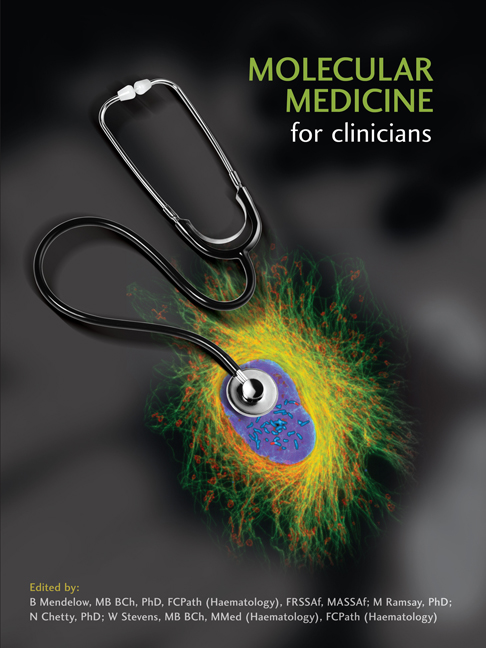Book contents
- Frontmatter
- Contents
- Foreword
- Acknowledgements
- Chapter 1 Introduction
- Keynote Essay 1: Defining Who We Are: DNA in Forensics, Genealogy and Human Origins
- Section 1 Principles Of Cellular And Molecular Biology
- SECTION 2 MOLECULAR PATHOLOGY
- Chapter 8 Genomes and the Environment: An Overview of Molecular Pathology
- Chapter 9 Genetics, Genomics, Health and Disease: General Considerations
- Chapter 10 Chromosome Disorders
- Chapter 11 Mendelian Inheritance
- Chapter 12 Unusual Molecular Processes that Impact on Disease
- Chapter 13 Population Genetics
- Chapter 14 Complex Multifactorial Inheritance
- Chapter 15 Molecular Basis for Phenotypic Variation
- Chapter 16 Medical Genetics
- Keynote Essay 3: Human Cloning: Should We Go There?
- Chapter 17 Neoplasia: General Considerations
- Chapter 18 Oncogenes
- Chapter 19 Mammalian DNA Repair
- Chapter 20 Tumour Suppressor Genes and Inherited Susceptibility to Cancer
- Chapter 21 Carcinoma
- Chapter 22 Leukaemias and Lymphomas
- Chapter 23 Molecular Approaches to the Diagnosis, Prognostication and Monitoring of Cancer
- Keynote Essay 4: Microbes, Molecules, Maladies and Man
- Chapter 24 Molecular Basis of Infectious Diseases: General Considerations
- Chapter 25 Immunology
- Chapter 26 Human Immunodeficiency Virus
- Chapter 27 Tuberculosis
- Chapter 28 Malaria
- Chapter 29 Influenza
- Chapter 30 Oncogenic Viruses
- Chapter 31 Vaccines and Immunisation
- Keynote Essay 5: Drugs and the 21st Century
- SECTION 3 MOLECULAR THERAPEUTICS
- SECTION 4 RESEARCH AND THE CONTINUING EVOLUTION OF MOLECULAR MEDICINE
- Glossary
- Contributors’ Biographies
- Source Material And Recommended Reading
- Permissions And Credits
- Index
Chapter 22 - Leukaemias and Lymphomas
from SECTION 2 - MOLECULAR PATHOLOGY
Published online by Cambridge University Press: 04 June 2019
- Frontmatter
- Contents
- Foreword
- Acknowledgements
- Chapter 1 Introduction
- Keynote Essay 1: Defining Who We Are: DNA in Forensics, Genealogy and Human Origins
- Section 1 Principles Of Cellular And Molecular Biology
- SECTION 2 MOLECULAR PATHOLOGY
- Chapter 8 Genomes and the Environment: An Overview of Molecular Pathology
- Chapter 9 Genetics, Genomics, Health and Disease: General Considerations
- Chapter 10 Chromosome Disorders
- Chapter 11 Mendelian Inheritance
- Chapter 12 Unusual Molecular Processes that Impact on Disease
- Chapter 13 Population Genetics
- Chapter 14 Complex Multifactorial Inheritance
- Chapter 15 Molecular Basis for Phenotypic Variation
- Chapter 16 Medical Genetics
- Keynote Essay 3: Human Cloning: Should We Go There?
- Chapter 17 Neoplasia: General Considerations
- Chapter 18 Oncogenes
- Chapter 19 Mammalian DNA Repair
- Chapter 20 Tumour Suppressor Genes and Inherited Susceptibility to Cancer
- Chapter 21 Carcinoma
- Chapter 22 Leukaemias and Lymphomas
- Chapter 23 Molecular Approaches to the Diagnosis, Prognostication and Monitoring of Cancer
- Keynote Essay 4: Microbes, Molecules, Maladies and Man
- Chapter 24 Molecular Basis of Infectious Diseases: General Considerations
- Chapter 25 Immunology
- Chapter 26 Human Immunodeficiency Virus
- Chapter 27 Tuberculosis
- Chapter 28 Malaria
- Chapter 29 Influenza
- Chapter 30 Oncogenic Viruses
- Chapter 31 Vaccines and Immunisation
- Keynote Essay 5: Drugs and the 21st Century
- SECTION 3 MOLECULAR THERAPEUTICS
- SECTION 4 RESEARCH AND THE CONTINUING EVOLUTION OF MOLECULAR MEDICINE
- Glossary
- Contributors’ Biographies
- Source Material And Recommended Reading
- Permissions And Credits
- Index
Summary
INTRODUCTION
Cells within a multicellular organism are genetically encoded to function in the best interests of the organism as a whole. As such, each cell receives signals from its own cytoplasm and nucleus (such as those provided by the cell cycle machinery) and from outside the cell (such as those provided by cytokines and growth factors). These signals are integrated within the cell to give a cohesive picture of what is required by the organism as a whole. Each cell uses this information to commit to one of three options, namely entry into the cell cycle and proliferation (cell division to create identical daughter cells), cell differentiation (acquisition by the cell of its more specialised functions), or apoptosis (program - med cell death).
A malignancy may arise when any one of these processes escapes its normal control mechanisms, leading to uncontrolled expansion or persistence of an abnormal clone of cells. Malignancies therefore arise by one of three major mechanisms:
• Excessive proliferation of cells
• Failure of cells to differentiate normally
• Failure of cells to undergo normal cell death (apoptosis).
Although one mechanism usually predominates in haematological malignancies, often the other mechanisms contribute to oncogenesis. By definition, a malignancy is monoclonal (i.e. arises from a single abnormal cell), with any abnormalities in the genome being passed from parent to daughter cell. Additional mutations may be acquired by the daughter cells leading to a progressive increase in aggressiveness of the malignancy.
To recapitulate from the previous chapters, two major groups of genes have been shown to play a role in malignancy, namely the oncogenes and the tumour suppressor genes. Proto-oncogenes (normal cellular counterparts of oncogenes) are commonly the cell cycle stimulatory proteins (such as growth factors, growth factor receptors or downstream stimulatory molecules). These molecules cause malignancy through gain of function mutations. Tumour suppressor genes are the cell cycle brakes (or control proteins) and are active at the cell cycle checkpoints. The loss of tumour suppressor function is associated with malignant change.
BASIC PATHOLOGY OF THE LEUKAEMIAS AND LYMPHOMAS
The leukaemias are a broad group of malignancies of cells of haemopoietic lineage, which involve the bone marrow and the peripheral blood.
- Type
- Chapter
- Information
- Molecular Medicine for Clinicians , pp. 261 - 270Publisher: Wits University PressPrint publication year: 2008



